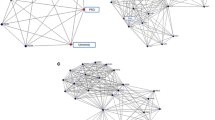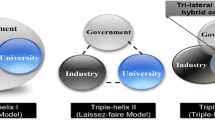Abstract
This study is to examine the structure, characteristics, and change of a research collaboration network using co-assignee information of joint patents in Korea. The study was conducted in three stages: data collection, network construction, and network analysis. For network analysis, network topological analysis, node centrality analysis, and block modeling were performed in sequence. The analysis results revealed that the network has small-world properties. The results also showed that while government-sponsored research institutes (GRIs) played a role as a hub and bridge in the network in the early 2000s, universities gradually took their place to play a key role as a hub and bridge in the network. In addition, the block modeling analysis indicated that while, in the early 2000s, GRI-centered network density was shown to be high, the network density became concentrated around universities after 2004, and this tendency intensified after 2008. Bearing in mind a lack of empirical studies on inter-organizational research collaboration networks using patent data, this study made an academic contribution by specifically analyzing the structure and change of research collaboration networks by targeting Korea’s major innovative actors. From the policy perspective, it provides important implications for figuring out the effects of university–industry–GRI (UIG) collaboration policies implemented so far, and can be of assistance for making evidence-based policies to build up a more effective UIG collaboration network or establish a new national science and technology innovation system.






Similar content being viewed by others
Notes
This is a pay service provider of patent information searches and offers sets of commercially produced patent data in the Korean language. It also provides the same services in English (www.wipsglobal.com), in Chinese (www.wipsglobal.com/servicecn/mai/main.wips) and in Japanese (www.patbridge.com).
References
Albert, R., & Barabási, A. L. (2002). Statistical mechanics of complex networks. Reviews of Modern Physics, 74(1), 47–97.
Amaral, L. A. N., & Uzzi, B. (2007). Complex systems—A new paradigm for the integrative study of management, physical, and technological systems. Management Science, 53(7), 1033–1035.
Barabási, A., Jeong, H., Neda, Z., Ravasz, E., Schubert, A., & Vicsek, T. (2002). Evolution of the social network of scientific collaborations. Physica A: Statistical Mechanics and its Applications, 311(3–4), 590–614.
Breschi, S., & Cusmano, L. (2004). Unveiling the texture of a European research area: Emergence of oligarchic networks under EU framework programmes. International Journal of Technology Management, 27(8), 747–772.
Chiffoleau, Y. (2005). Learning about innovation through networks: the development of environment-friendly viticulture. Technovation, 25(10), 1193–1204.
Choe, H., Lee, D. H., Seo, I. W., & Kim, H. D. (2013). Patent citation network analysis for the domain of organic photovoltaic cells: Country, institution, and technology field. Renewable and Sustainable Energy Reviews, 26, 492–505.
Clauset, A., Shalizi, C. R., & Newman, M. E. J. (2009). Power-law distributions in empirical data. SIAM Review, 51(4), 661–703.
Defazio, D., Lockett, A., & Wright, M. (2009). Funding incentives, collaborative dynamics and scientific productivity: Evidence from the EU framework program. Research Policy, 38(2), 293–305.
Freeman, L. C. (1979). Centrality in social networks conceptual clarification. Social networks, 1(3), 215–239.
Gay, B., & Dousset, B. (2005). Innovation and network structural dynamics: Study of the alliance network of a major sector of the biotechnology industry. Research Policy, 34(10), 1457–1475.
Granovetter, M. (1973). The strength of weak ties. American Journal of Sociology, 78(6), 1360.
Horowitz, E., Mehta, D., & Sahni, S. (1995). Fundamentals of data structures in C++.
Hou, H., Kretschmer, H., & Liu, Z. (2008). The structure of scientific collaboration networks in scientometrics. Scientometrics, 75(2), 189–202.
Kamada, T., & Kawai, S. (1989). An algorithm for drawing general undirected graphs. Information processing letters, 31(1), 7–15.
Katz, J. S., & Martin, B. R. (1997). What is research collaboration? Research Policy, 26(1), 1–18.
KIAT. (2011). 2011 Korean industrial R&D investment scoreboard of the top 1000 R&D investors. Seoul: Korean Institute for Advancement of Technology.
Kim, C., & Song, J. (2007). Creating new technology through alliances: An empirical investigation of joint patents. Technovation, 27(8), 461–470.
Kim, H. D., Lee, D. H., Choe, H., & Seo, I. W. (2014). The evolution of cluster network structure and firm growth: A study of industrial software clusters. Scientometrics, 99(1), 77–95.
Koschützki, D., Lehmann, K. A., Peeters, L., Richter, S., Tenfelde-Podehl, D., & Zlotowski, O. (2005). Centrality indices. In Network analysis (pp. 16–61): Springer.
Lee, P.-C., & Su, H.-N. (2010). Investigating the structure of regional innovation system research through keyword co-occurrence and social network analysis. Innovation: Management, Policy & Practice, 12(1), 26–40.
Lee, J. Y., Kim, Y. H., & Lee, H. J. (2011). A survey of research and development in Korea, 2010. Seoul: National Science & Technology commission.
Lee, D. H., Seo, I. W., Choe, H. C., & Kim, H. D. (2012). Collaboration network patterns and research performance: the case of Korean public research institutions. Scientometrics, 91(3), 925–942.
Melin, G., & Persson, O. (1996). Studying research collaboration using co-authorships. Scientometrics, 36(3), 363–377.
Moody, J. (2004). The structure of a social science collaboration network: Disciplinary cohesion from 1963 to 1999. American Sociological Review, 69(2), 213–238.
Mote, J. E., Jordan, G., Hage, J., & Whitestone, Y. (2007). New directions in the use of network analysis in research and product development evaluation. Research Evaluation, 16(3), 191–203.
Newman, M. E. (2001). Scientific collaboration networks. I. Network construction and fundamental results. Physical Review E, 64(1), 016131.
NRF. (2011). An analysis of research and development in Korean universities, 2011. Daejeon: National Research Foundation.
NRF. (2012). University–industry collaboration white paper in 2010. Daejeon: National Research Foundation.
NRF (2013). BK21.NURI Commitee. http://bnc.krf.or.kr/home/eng/index.jsp. Accessed October 2013.
Okamura, K., & Vonortas, N. S. (2006). European alliance and knowledge networks. Technology Analysis & Strategic Management, 18(5), 535–560.
Otte, E., & Rousseau, R. (2002). Social network analysis: a powerful strategy, also for the information sciences. Journal of information Science, 28(6), 441–453.
Park, S. D. (1998). The role of government-sponsored institutes: Past, present, and future. Journal of Technology Innovation, 6(1), 30–50.
Park, K.-H., Kwon, K. S., Eun, J. H., Han, D. S., Han, Y. J., & Han, S. H. (2007). Analysis on the impact of university–industry collaboration policy on research activities and patenting activities in Korean universities. Seoul: Korea Research Foundation.
Powell, W. W., Koput, K. W., & Smith-Doerr, L. (1996). Interorganizational collaboration and the locus of innovation: Networks of learning in biotechnology. Administrative Science Quarterly, 41(1), 116–145.
Powell, W. W., White, D. R., Koput, K. W., & Owen-Smith, J. (2005). Network dynamics and field evolution: The growth of interorganizational collaboration in the life sciences1. American Journal of Sociology, 110(4), 1132–1205.
Ramasco, J. J., Dorogovtsev, S. N., & Pastor-Satorras, R. (2004). Self-organization of collaboration networks. Physical Review E, 70(3), 036106.
Subramanyam, K. (1983). Bibliometric studies of research collaboration: A review. Journal of information Science, 6(1), 33–38.
Tomassini, M., & Luthi, L. (2007). Empirical analysis of the evolution of a scientific collaboration network. Physica A: Statistical Mechanics and its Applications, 385(2), 750–764.
Tomassini, M., Luthi, L., Giacobini, M., & Langdon, W. B. (2007). The structure of the genetic programming collaboration network. Genetic Programming and Evolvable Machines, 8(1), 97–103.
Uzzi, B., Amaral, L. A., & Reed-Tsochas, F. (2007). Small-world networks and management science research: a review. European Management Review, 4(2), 77–91.
van der Valk, T., Chappin, M. M., & Gijsbers, G. W. (2011). Evaluating innovation networks in emerging technologies. Technological Forecasting and Social Change, 78(1), 25–39.
Verspagen, B., & Duysters, G. (2004). The small worlds of strategic technology alliances. Technovation, 24(7), 563–571.
Wagner, C. S., & Leydesdorff, L. (2005). Network structure, self-organization, and the growth of international collaboration in science. Research Policy, 34(10), 1608–1618.
Yoon, J., Blumer, A., & Lee, K. (2006). An algorithm for modularity analysis of directed and weighted biological networks based on edge-betweenness centrality. Bioinformatics, 22(24), 3106–3108.
Acknowledgements
This work was supported by the National Research Foundation of Korea Grant funded by the Korean Government (2014S1A3A2044459).
Author information
Authors and Affiliations
Corresponding author
Rights and permissions
About this article
Cite this article
Choe, H., Lee, D.H. The structure and change of the research collaboration network in Korea (2000–2011): network analysis of joint patents. Scientometrics 111, 917–939 (2017). https://doi.org/10.1007/s11192-017-2321-2
Received:
Published:
Issue Date:
DOI: https://doi.org/10.1007/s11192-017-2321-2




